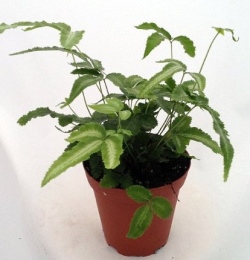





Botanical Name: Pteris cretica
Brake Fern adapts well to average indoor conditions, earning it another common name: Table Fern.
Many different varieties are available and they vary in leaf shapes and variegations. Some have frilly frond tips and some sport creamy white or silvery white stripes. All make attractive accents for a room.
Brake Fern is easier to please indoors than some other ferns. It does require bright light, so don't put it in a dark corner. Set it on a table or plant stand near a window to give it the sunlight it craves. Its fronds are somewhat fragile, so it's a good idea to keep this fern where passersby won't brush against its foliage.
Repot in spring, only when necessary. Brake Fern is slow-growing and prefers to be pot-bound. Keep the crown of the plant above the soil line when repotting, and use a pot with a drainage hole to avoid soggy soil.
Keep it compact by cutting off tall fronds at the base. New ones will grow to take their place.

Origin: Southern Mediterranean
Height: 6 in to 2 ft (15 cm - 60 cm), depending on the variety
Light: Moderate to bright (indirect) light. It also thrives under fluorescent light.
Water: Keep the potting mix lightly moist at all times. This Mediterranean fern needs slightly less water than its rainforest cousins, so take care not to overwater.
Humidity: Prefers moist air. Set pot on a tray of wet pebbles and mist foliage regularly with room- temperature water when humidity drops in winter.
Temperature: Cool nights (50-55°F/10-13°C) and warm days (60-70°F/16-21°C) will make this fern feel at home.
Soil: Any good-quality potting mix with added perlite for good drainage.
Fertilizer: Feed monthly spring through fall with a balanced house plant fertilizer diluted by half.
Propagation: Division. Divide large plants in spring only when crowded -- this fern is slow-growing and rarely needs divided.
Copyright © www.100flowers.win Botanic Garden All Rights Reserved